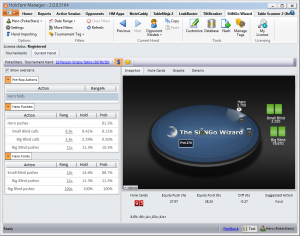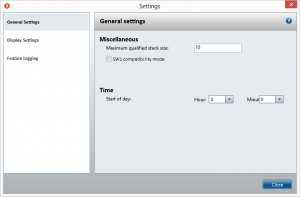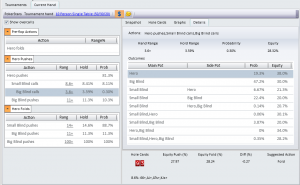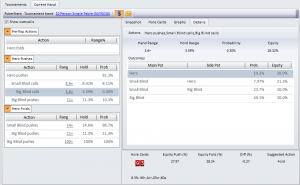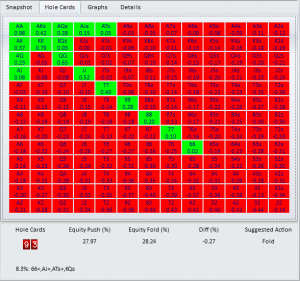SitNGo Wizard 2 (SW2) computes equity more accurately than SitNGo Wizard 1 (SW1). Here’s why.
When two players are all-in before the flop, three outcomes are possible:
- Player 1 wins.
- Player 2 wins.
- Both players tie.
In order to compute equity as fast as possible, SW1 approximated the case where both players tie by adding half the ties to Player 1’s wins and half the ties to Player 2’s wins. Ties usually occur a small percentage of the time, so this approximation usually has little effect on the final push/fold decision.
But it can have a significant effect when the hero has a top hand and opponents have small hand ranges. This combination makes ties occur more often.
SW2 computes equity when players tie separately and correctly, providing the most accurate analysis possible. An example will help illustrate.
An Example
Our example hand has 3 players with the hero on the button.
If we open the Details tab on the right and select the Hero pushes->Small Bllind calls action on the left, we see three possible outcomes in the Details view: Hero wins, Small blind wins, and Hero and Small Blind tie.
The third outcome (Hero and Small Blind tie) is new in SW2. In SW1, one-half of the tie outcome is added to the Hero wins outcome and one-half is added to the Small Blind wins outcome.
SW1 Compatibility Mode
To see how SW1 calculates the outcomes we can set the SW2 to compute equity just like SW1 does. To do this, open the Settings dialog and in the General settings tab check the “SW1 compatibility mode” check box.
When checked, this option causes SW2 to calculate equity the same as SW1. Now the “Hero pushes->Small Blind calls” detail view shows only two outcomes: Hero wins, and Small Blind wins.
By calculating tie outcomes separately, SW2 computes equity more accurately than SW1.
Three way all-ins
Three way all-in situations produce even more possible outcomes. Here is a comparison of the Hero pushes->Small Blind calls->Big Blind calls action.
SW2 has 9 possible outcomes, while SW1 has only 4 possible outcomes.
The Bottom Line
So how much does the more accurate equity calculation affect which hands we can push with? For most situations, it has only a small effect. Here is the difference for our example hand.
In this example, the more accurate analysis changes only one hand: KJs becomes a push instead of a fold. This is typical for most situations. But for some hands where ties are more likely the new equity calculation can make a significant difference in the analysis.

